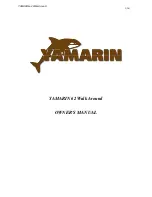
trim system allows the operator to adjust the drive angle while under-
way by changing the angle of the outdrive in relation to the boat’s
transom. It also allows the operator to raise and lower the drive for
trailering, beaching, launching, or operating in shallow water.
Note: Refer to your engine owner’s manual regarding the oper-
ation of the power trim controls installed on your boat.
Drive Angle
The drive angle of the boat is the relationship between propeller
thrust to the planing surface of the hull’s bottom. You can improve
the performance of the same boat under varying conditions by
adjusting the drive angle.
Moving the drive unit angle towards its innermost adjustment brings
the propeller in as close as possible to the transom. The angle of
the propeller causes an upward thrust which pushes the boat’s bow
downward as shown on Figure 5.3.
By gradually shifting the drive unit from its innermost adjustment
towards the outermost adjustment, the propeller thrust pushes in a
downward motion. This motion as shown in Figure 5.3, tends to lift
the bow.
After reaching plane, under certain load conditions, your boat could
have a tendency to bury its forward V-ed section. The boat will
begin to plow and lose speed. If the water is choppy the boat will
yaw. A boat will spin out if its bow is excessively buried. The only
way to correct this situation is to increase the angle and swing the
drive unit outward.
If the drive unit is angled out too far, your loaded boat will be slug-
gish in coming to plane. Once on plane, your boat will tend to
porpoise. To correct this motion, move the propeller inward to
decrease the angle between the drive shaft and the transom.
Very often, the optimum drive unit angle setting for the highest
speed while carrying a light load will be just short of the porpoise
point. However, such a setting is unsuitable when you have a heavy
load or are pulling skiers. By reducing the drive angle, you will find it
easier to maneuver the boat and to pull skiers to the surface.Turn-
Stopping Your Boat
A boat has no brakes. Stop the boat by allowing it to slow down to
less than 5 miles per hour and then putting the engine in reverse.
Slowly increasing reverse power will allow you to stop the boat in a
short distance. Remember that a boat does not respond to steering
in reverse as well as it does when going forward.
Additional Underway Information
•
Be sure to run the bilge blower whenever the boat is operated
under cruising speed.
•
Keep all bilge blower and engine compartment vents free of
obstructions to allow proper ventilation.
•
Always be aware of local laws on noise limits. Noise means
engine noise, radio noise or even yelling by people on your
boat. Good seamanship demands that you operate your boat
quietly so as not to infringe on the rights of others. Don’t use
thru-transom exhaust unless you are well offshore.
5-11
WARNING:
Excessive trim decreases maneuverability,
changes steering characteristics, and may cause “porpoising”
(bow oscillates up and down) or “chine walking” (rocking side to
side). Use power trim with care.
Содержание 2012 H2O Series
Страница 15: ...1 7...
Страница 16: ......
Страница 20: ......
Страница 75: ......
Страница 83: ......
Страница 89: ......
Страница 90: ...WIRING SCHEMATICS 12 12 1 H2O INST PNL PIGTAIL...
Страница 91: ...12 2 H20 INST PNL PIGTAIL...
Страница 92: ...12 3 H20 DECK DISTRIBUTION HARNESS...
Страница 93: ...12 4 H20 DECK DISTRIBUTION HARNESS...
Страница 94: ...12 5 H2O HULL DISTRIBUTION HARNESS...
Страница 95: ...12 6 H20 OPTIONAL AERATOR DECK HARNESS...
Страница 96: ...12 7 H2O OPTIONAL AERATOR HULL HARNESS...
Страница 97: ...12 8 H2O MERCURY ENGINE HARNESS ANALOG...
Страница 98: ...12 9 H2O TROLLING MOTOR PLUG WIRING...
















































